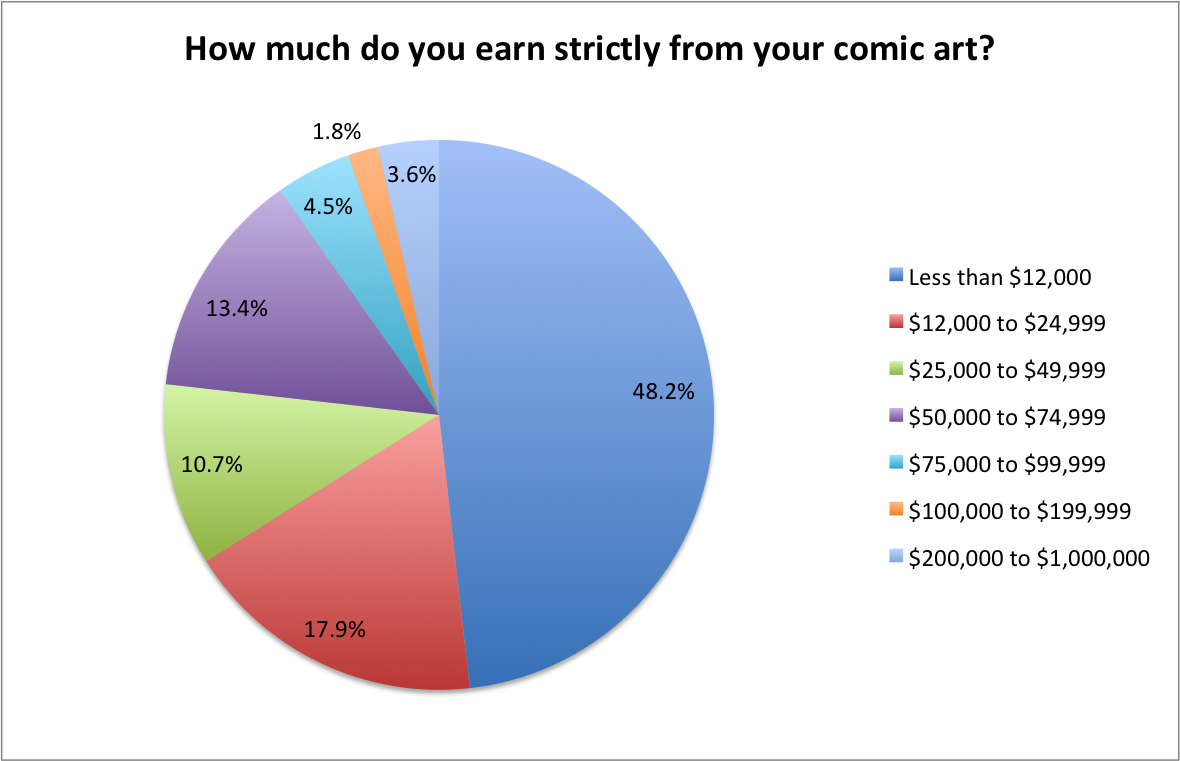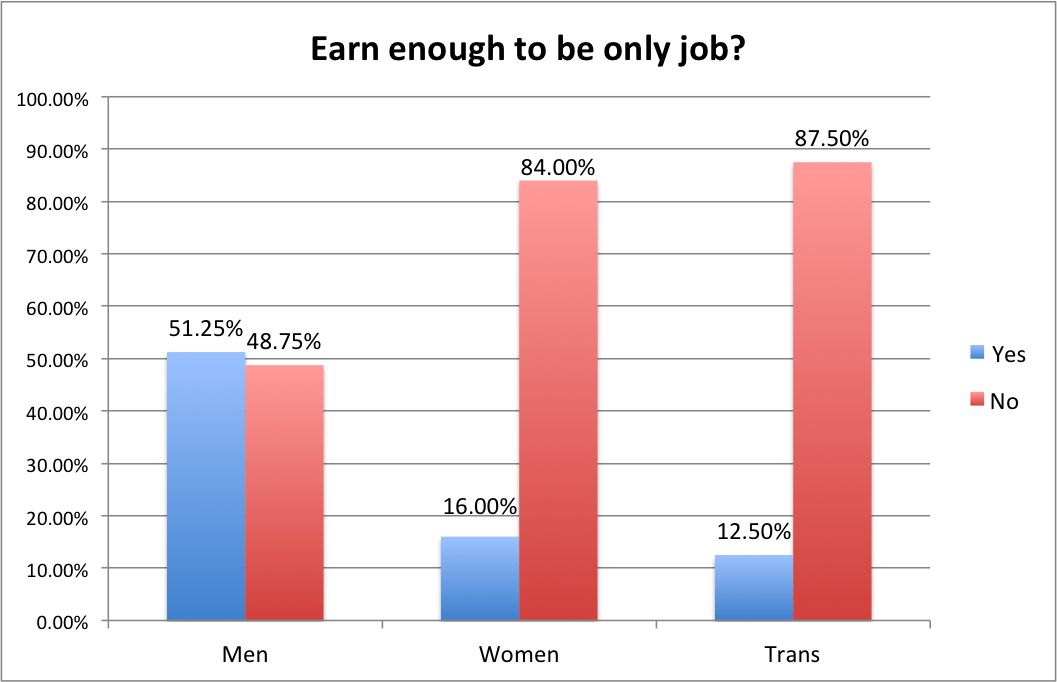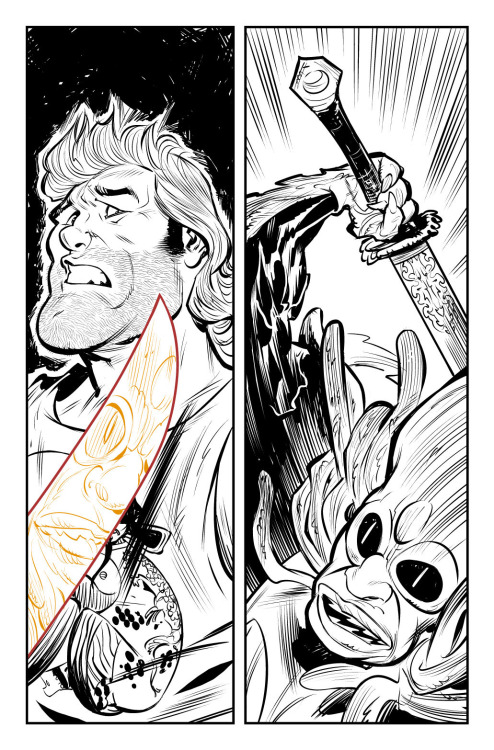Being in comics is great, it’s a golden era, new readers, yadda yadda. But this golden era is mostly the product of people slaving away at drawing boards and computers for long hours and a meagre living. And now here are some numbers to prove it. David Harper, formerly of Multiversity, has just launched his own site, called Sktchd and he’s continuing the valuable longform pieces that were the best part of the old site. Recently he sent out a survey for artists to explain who they are and what they do and 186 of them responded. You’ll want to read the whole thing as it has some metrics on gender, income, publishers and much more. (David lives in Alaska and they have free time there, I guess.) Broken down with a ton of charts and graphs it’s a non-statistically valid snapshot, but the numbers are sobering. Let’s just get to the bottom line here., since that’s what you came for.

Forget getting rich though. Can artists even make enough to get by off their art? Mostly, the answer is no, they can’t. Almost 60 percent of artists who responded shared they can’t make a living off their work. What that means is many artists live interesting double lives. While many mentioned that they did freelance illustration, animation, advertising work, storyboards or other art related jobs to supplement their income, there were others who worked in factories, as bartenders, or even in one special case, lived off earnings as a figure drawing model and a tarot card reader.
Others bring in income from alternative sources, including working in a shared income household with a spouse and leveraging Patreon and other crowd-sourcing outfits to help them get by. Artists may not be making the big bucks, but they are a resilient and resourceful group.
There’s much more to chew on, including satisfaction with publishers, with DC?Vertigo getting high marks and Boom and Dynamite getting low marks, formats, art methods and so much more. Like I said read the whole thing, quote it, make it a part of your life.
In a subsequent post, Harper goes even further into the maw of the cyclone and breaks things down by gender. And it looks bad.

While this seems to make the case that cis men are generally paid more for comics than non cis males, Harper points out that more women, trans and non-binary creators just started their careers, and more work outside the relatively lucrative field of monthly floppies:
When you take the data for the comics creators work on and cross-reference it with the variables based around money, that’s when you see an additional correlation. More than half of floppy artists make enough money for that to be their only job. It’s the only format where that is the case, with over 80 percent of webcomic creators being unable to make a living off their work. Additionally, the majority of graphic novel and webcomic artists who responded make less than $12,000 a year off their work, and as a whole make less money than those who work on floppy comics.
As shown above, while men work more frequently in floppies, women, trans*, non-binary and agender artists most often work in graphic novels and webcomics, per the survey. Because of that additional correlation, the question becomes a chicken and the egg one: were the non cis male artists who responded more poorly compensated because of their gender or because of the format they work in?
Or perhaps because most floppy decision makers are cis males?
Lest ye despair at all this, it’s worth pointing out that the fast growing field of kids and YA graphic novels is dominated by women—and there are a few trans creators doing well there too. This is far from being a universal money spout, but it’s an alternative.
I’ve written here a few times about how page rates in comics have not gone up except for the tippity top guys, and a few other recent posts have driven that home. Janelle Asselin recently pointed out that today’s page rates are about where they were in a 1978 creators bill of rights. Thats unadjusted for inflation.
Adjusted for inflation, those rates today would be:
Artists: $1080
Writers: $360
Letterers: $144
Colorists: $252It’s not an overstatement to say that these rates, adjusted for inflation, dwarf most creators’ rates today. There are maybe a few very, very top level creators who make similar or higher rates, but primarily only writers and artists working at top-tier publishers. In fact, there are a lot of creators in comics today who don’t even make as much as the 1978 rates quoted without adjusting for inflation. And there are a lot of creators in comics who can’t afford to make comics full time because they don’t make enough doing so.
At Special Edition a few days ago, Alex De Campi put together some numbers on page rates:
WFH/PAGE MAINSTREAM INDIE Script $80-100 $25-50 Covers $600-700 $200-500 Line art $200-300 $100-250 Colour art $120-150 $35-100 Letters $20-25 $10-20
These rates are, shockingly, about where they were when I edited comics 15 years ago. The 1978 document called for a lettering rate of $40 a page, so there one thing that has become significantly devalued with time.
Finally, here’s another much linked to piece, from artist Brian Churilla, creator of Hellbreak and The Secret History of DB Cooper and currently Boom’s Big Trouble in Little China comic. Sounds like a guy who works steadily and makes a living at it, right? Not so fast. Basically Churilla backs up Harpers stats on living well below a “middle class” level, as if that even existed any more. Even more dismal is his time breakdown:
So. Here’s the schedule I keep:
7:00am – Wake up, feed the kids and get them ready for school.
8:30 – Take the kids to school
9:00-9:30am – Start work
12:30pm Pick up kid #1
3:30pm: Pick up kid #2
4:00-9:00pm – Family time.
9:00pm-3:00am Work
3:00am Sleep.
Yep. That’s four hours of sleep per day, best-case scenario. Weekends too. Due to the sleep deprivation, I feel like absolute garbage all the time. Depression, anxiety, nausea, fatigue, weight gain, compromised cognitive abilities, even hallucinations – I suffer from all of these.
40% of the artists in Harper’s survey report not even taking a day off a week. Not quite as awful as that manga-ka schedule we posted a few years ago where the poor guy had a total of three hours free time a week. But not that much better.
What does this all mean? I’m writing this on my own five-hours-of-sleep-a-night schedule, so I’m probably too brain befogged to figure it out. Clearly a lot of the success of some publishers is predicated on paying low rates; we all know that even if we don’t like saying it aloud. And younger creators seem willing to takes these rates in hopes of graduating to the comics 6% that makes a wage that allows for things like insurance, vacations and saving for retirement. I know that the happy face of the convention or small press show often masks a fraught life of financial stress.
Some of this is tied up in the increasing feudalism of society, with the few at the top becoming patrons for the peons slaving away at their Manga Studio or the local Wal-Mart. It’s harder to make a living at ANYTHING creative now. But comics have a low level economy to begin with.
I think a lot of people are going to drop out over the next few years, if you define dropping out as not trying to make a living at comics, while maybe making the occasional tumblr post. As comics become an accepted outlet of individual self-expression, it’s a lot like being in a band. You do it for a while while you’re young, but eventually you quit to concentrate on the kids and the mortgage. And that’s okay, because it’s the game of life.
But in the larger picture, an industry where an artist makes 33% of what the living wage was 37 years ago, maybe isn’t the healthiest place to be. And that’s something we all need to do something about.




The job of lettering has changed pretty profoundly since 1978, become less time-and-labor intensive than it once was (in a way that that writing, penciling, and inking have not) so it isn’t surprising that it’s been devalued.
Here’s the deal, and basic economics, say you raise the rates of these creators (and believe me, I have a lot of sympathy, as I’m a creator, too), you have to raise the price of the material compensate for that, and when prices rise, buyers cut back, you lose sales. The end. It’s a terrible catch-22 with no fix. There will always be us grunts who will suffer for our art.
Personally I find myself hustling non stop to make a living as an artist. Small press children’s book here, small press comic book there, commissions, print sales at conventions, and my own comic book… which just about breaks even but only because I can do all of it myself. Once I start hiring out parts of it, the story changes.
But – there seem to be a LOT more people now cranking out GOOD QUALITY STUFF than what I remember, growing up in the 80s and 90s. So dollars are spread around a bigger pool of comics. Which is great for the comics fan…. doesn’t bode well for the moneymaking aspects of the indie cartoonist but, honestly, how many of us are in it for the money??
This isn’t necessarily true:
Basic economics… say[s] you raise the rates of these creators (and believe me, I have a lot of sympathy, as I’m a creator, too), you have to raise the price of the material compensate for that…
Creators are one paycheck of many in comics. You could pay creators more if you paid company executives, editors and other non-creatives less. Or maybe if you paid creators more you’d get a better product, which could perhaps sell more?
Trans? You decided to force Transgender into the article about if comic artists make enough money? Maybe when you ask why you are not making enough money as a writer, Heidi, you will realize it’s because you get too distracted to stay on topic.
A lot of factors to consider here regarding the relatively low wages, such as supply and demand (i.e., the number of people wishing to break in versus the number of available spots, let alone how much money publishers make), historical lack of union representation/advocacy, etc. And how does this compare with other arts-related fields? For example, one always hears how little money most actors make, except for the top tier of stars. And they DO have union representation in many cases.
Perhaps you’re too distracted to understand the topic, Rich.
If there was any truth to the whole “rising rates means rising the produt’s price” angle, then serious publishers of both books and magazines would be paying a lot less than they actually do… but they don’t.
The problem is, in comics you got a bunch of small companies pretending their business and readership is bigger than it really is, demanding top level results, but not really able to pay top dollar for it; so instead they become meat grinders for young men and women who don’t know any better, or those who like to think a person should invest his/her time/life for the enjoyment comics alone bring.
This isn’t new by any chance, but the law of the land in comics world.
Who are the people making the money in comic books? Note to Rich: Stop being so mean. Transgender is pervasive. Welcome to the Twenty-First Century!
As for the supply and demand aspect Randy mentions, the sad truth is in an industry fueled by fans and geared towards them as their main audience, no publisher would risk alienating all the fans who want to turn pro by telling them that the number of people wishing to break is far greater than the number of available work spots… it is far mor convenient to keep them hopeful and standing in line at comic-conventions portfolio reviews, so they’ll keep buying.
There are always more people who want to make comics than there are available opportunities. So, the pay is low. It’s that way in much of the arts. And that’s terrible, of course. We are people who are so passionate about our creative work that we’ll do it 20 hours a day for very little pay. You don’t see bridge engineers sending a cash deposit to apply for an apprenticeship, or interning for free. But again, that’s the Arts.
As a reality check on those 1978 “recommended rates” by the (never actually formed?) “Comic Book Creators Guild”, we know by his 1977 contract (made public through being involved in a lawsuit) that Steve Gerber’s rate at Marvel at the time was $26.50 per page, and when he signed that contract Gerber was as hot a name as a writer in comics at the time could be, so I’m sure getting close to the top rate offered. So that $100 per page that the “Guild” recommended was 4x what was realistic, and the other rates are probably similarly inflated (never mind that a 25% of original rate for foreign rights was compared to the 0% that most publishers at the time offered, and the 50% of original rate for reprints was probably closer to 10% for those few publishers that paid anything for reprints).
@Doug — when you look at some of the actual numbers behind publishing projects, though, you see that there’s almost never that one to one relationship between the creative costs and the net loss/gain, especially with page rates. A million dollar advance, sure, that could kill a profit margin, but paying an artist an extra $1,000 for their work won’t make a dent in a serious publisher’s bottom line (but it would mean the end of poverty for some artists).
The main reason creators get paid so little is because publishers don’t value their contribution as highly as the marketing and sales and other home office staff. That doesn’t mean they’re evil, it just means they see the other stuff as more necessary, maybe higher skilled, less easy to replace. You can easily build a spreadsheet around a fair wage for creators — heck, maybe even a salary — because those costs are small compared to your more dramatic cost savings from reducing page count or changing printers or selling more books (which few comics publishers actually try to do).
Just wondering if the income for creators is any better at companies like Image where the creators have a better deal with their creator-owned material?
“You don’t see bridge engineers sending a cash deposit to apply for an apprenticeship, or interning for free.”
I don’t know about engineers in particular, but in the current job market there are a lot of non-BFA college grads who resort to interning for free.